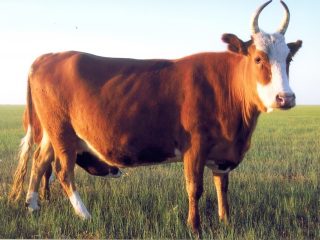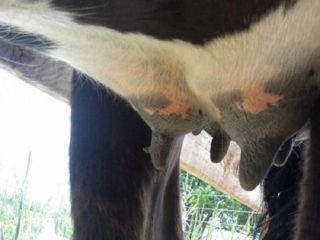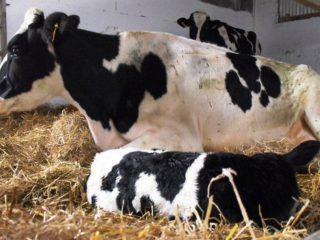Content
In the Soviet years, thanks to experiments and the search for the cheapest feed, the belief spread that a cow could eat almost anything. They gave the cattle cut paper instead of straw, they did not die. In some places they tried to add dried jellyfish to the feed. Fortunately, such experiments remained at the exotic level, since tympania in cattle is a very common phenomenon. Mild forms often even go unnoticed. But if the disease has become severe, the cow needs immediate help. Otherwise, the animal may die.
What is tympania
In common parlance, this phenomenon is often referred to as "swollen cow". The popular name is apt. Tympania is an excessive accumulation of gases in the rumen of cattle. In animals with a single stomach, this is called flatulence. Sometimes it can go away on its own, but often the animal needs help. There are 3 types of scar bloating:
- chronic;
- primary;
- secondary.
An acute course occurs with primary and secondary forms of swelling. When treating cattle for tympanic scarring, it is good to know the history of the disease, since each type has its own cause of origin.
Causes of Tympania in Calves and Cows
Stomach gas in cattle is normal. When cows chew gum, they regurgitate gas along with the feed. The latter accumulate in the scar when the act of belching is blocked. If the cattle chews gum, you can be calm: he has no tympania.
Very often, cattle "swell" when they suddenly switch from one type of feed to another, or when a large amount of juicy feed is introduced at once. The latter is often practiced in order to get as much milk as possible from a dairy cow.
Tympania in young animals
Calves often develop bloating when they are switched from milk to plant-based feed.
Since the owners usually do not particularly fool themselves, this transition occurs quite abruptly. In nature, a calf can suckle for up to 6 months. But milk is not enough, so the cub consumes more and more vegetation as it grows. For a private trader who has bought a 2-month-old calf, such conditions are impracticable. Even if there is a cash cow in the yard, a person will not be able to constantly run to feed the calf. Therefore, young animals are usually transferred to "adult" feed within a week. And at the same time they get tympania.
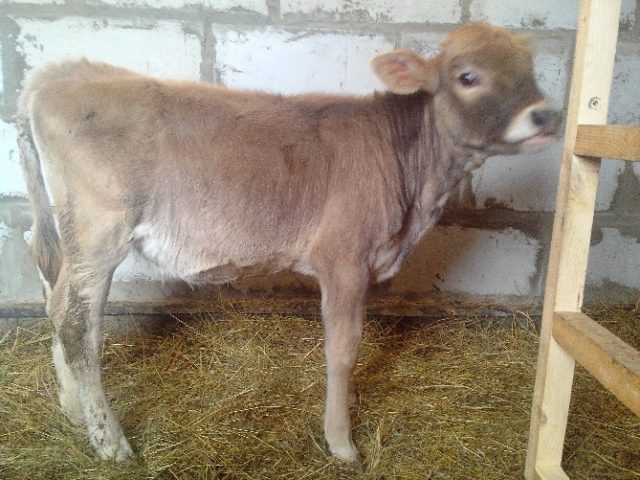
Abrupt transfer of calves to adult food is a common cause of rumen swelling.
Acute primary
The acute course of the primary type of tympania occurs if the cattle receives a large amount of easily fermenting feed in one feeding:
- clover;
- wiki;
- alfalfa;
- cabbage;
- tops;
- maize in the stage of milk ripeness;
- winter crops.
These feeds are especially dangerous if fed raw, frosty or self-heating.
The primary acute form of the disease is also often caused by frozen roots:
- potatoes;
- turnip;
- carrot;
- beet.
All of the above feeds belong to the category of milk-producing ones, therefore they are almost mandatory included in the diet of cattle. To prevent tympania, it is necessary to monitor the quality and condition of these feeds. Moldy or rotten food must not be fed. Spoiled grain and stillage, as initially potentially fermentable products, are almost guaranteed to cause tympanic symptoms.They can only be fed fresh.
Acute secondary
This type can occur when:
- blockage of the esophagus;
- acute infectious diseases, one of which is anthrax;
- some plant poisoning.
Secondary tympania cannot be cured without addressing the true cause of the bloating.
Chronic form
The reason for this form of tympania in cattle is other internal diseases:
- compression of the esophagus;
- diseases of the gastrointestinal tract, liver, abomasum;
- traumatic reticulitis.
The chronic form of cattle can suffer for several months, but without eliminating the cause, the process will inevitably lead to the death of the animal.
Symptoms of tympanic scar in cattle
In the case of acute tympania, the process develops very quickly:
- the abdomen increases sharply;
- the left "hungry" fossa begins to protrude;
- the work of the scar first weakens, and then stops altogether;
- the animal is anxious;
- shortness of breath appears;
- palpitations are frequent and weak;
- cyanosis of the mucous membranes.
When tapping on the abdominal wall, a drum sound is heard.
A variety of the acute form of tympania with gas formation is foamy. The gases released are mixed with the contents of the stomach and "lubricate" the picture. Anxiety in cattle with frothy tympanic symptoms is less pronounced.
With the provision of timely assistance, the prognosis is favorable.
Chronic tympania is characterized by the fact that the scar swells up periodically. Often after feeding. In chronic tympania, scar swelling is less pronounced than in the acute form. A gradual exhaustion of the animal is observed. The disease can last for several months. The prognosis depends on the underlying disease.
Diagnosis of tympania
Intravital tympania is diagnosed by a cow swollen like a balloon. If there was a normal animal and suddenly found itself "in the last month of pregnancy", you can not look for other signs: it is tympania. To be sure, you can tap your fingers on a swollen belly and listen to a booming sound, compare the sides (the left one sticks out more) and see if the cow is chewing gum. If the latter is not there, and everything else is there, then this is tympania.
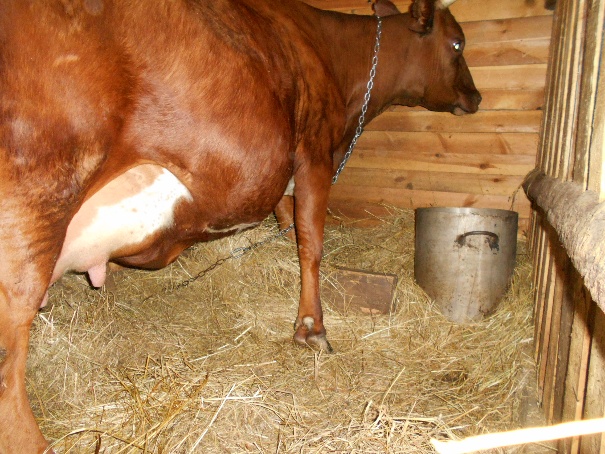
It is unlikely that from the photo, without seeing the process in dynamics, someone will be able to determine whether this cow is pregnant or swollen with gases.
Pathological changes
If the cattle has managed to fall from tympania, at autopsy they find:
- blood-filled muscles of the front of the body, especially the neck and front legs;
- gas escapes from the cut rumen and the foamy contents are poured out;
- the spleen is pale, compressed;
- the kidneys are pale, autolyzed, there are areas with a rush of blood;
- the liver is partially autolyzed, ischemic.
In other words, when tympanic occurs, the liver and kidneys are not completely preserved.
Treatment of tympanic rumen in cattle
Since tympania is a fairly common occurrence in cattle, the owner's first-aid kit should contain:
- formalin, lysol or ichthyol;
- tympanol, vegetable oil or liquid paraffin, sicaden.
These elements are kind of synonyms. You do not need to use them all at once, but you should always have one drug from these two points at home.
Without these drugs, the prognosis for acute gas typing is unknown. The veterinarian may not have time to get there, since treatment must be started as soon as a swollen cow was found:
- to weaken the fermentation process in the rumen: 10-20 g of ichthyol / 10-15 ml of formalin / 5-10 ml of lysol is mixed with 1-2 liters of water and poured inside;
- to break up foam by mouth: 200 ml of tympanol / 150-300 ml of vaseline or vegetable oil / 50 ml of sicaden mixed with 2-5 liters of water;
- for adsorption ("precipitation") of gases: 2-3 liters of fresh milk or 20 g of burnt magnesia.
Of the oils, vaseline is better, since it only covers the intestinal walls from the inside, but is not absorbed by the cattle body.
To excite the eructation, the cattle is placed with its front legs on an elevation and the scar is massaged with a fist. You can also try:
- rhythmically stretch the tongue with your hand;
- irritate the palatine curtain;
- pour cold water on the left sigh;
- bridle a cow with a thick rope;
- slowly lead the animal up the hill.
There is also a rather amusing "folk way" from the category of "magic": to close the eyes of the cow with the hostess's nightgown and lead her (the cow, but it is possible with the hostess) through the threshold of the barn. The threshold should be high. There is a rational grain here: crossing the threshold, the cow is forced to strain the abdominal muscles, and this contributes to the appearance of belching. And if the cattle close their eyes, the animal becomes much calmer. This is important when tympanic, as the cow is often very irritated due to the pain. So any suitable cloth can play the role of a shirt. In the 19th century, if tympania appeared in the middle of the night, they threw what was at hand on the head of the cattle, hence the shirt.
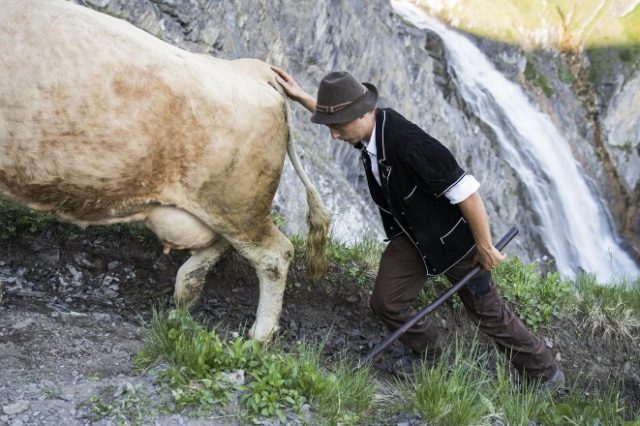
It's good when there is a suitable slide
All these activities are carried out before the arrival of the veterinarian. If by that time tympania has not passed or it turned out to be a severe form of the disease, the cattle scar is probed, releasing gases. Using the same probe, the stomach is washed with a solution of potassium permanganate in a ratio of 1:10 000. The second option for freeing the scar from gases: puncture with a trocar.
If foam has formed in the stomach, the puncture will be useless: only a small amount of foam can escape through the trocar sleeve. In this case, the scar is washed with a probe, and the cattle are given orally foam-destroying drugs and eructations.
During the recovery period, cattle are kept on a limited diet.
Preventive actions
Tympania prophylaxis is "standard". The same recommendations can be found in almost any gastrointestinal disease:
- providing cattle with good quality feed;
- limiting those types of feed that can cause fermentation in the stomach;
- a ban on cattle grazing on wet leguminous grasses: clover, alfalfa, peas and others;
- gradual transfer to grazing with rich herbage, especially after the winter period. The first time it is advisable to feed hay before pasture;
- timely vaccinations against anthrax;
- instructing cattlemen and shepherds on measures to prevent tympania.
The latter, however, is not feasible for private households. Either the owner knows, or the hired shepherd, no matter how you instruct, will not help.
In the West, tympania is increasingly prevented by implanting a special ring with a lid in the side of the cow. Even in severe cases of tympania, any person can cope with the problem: it is enough to open the hole in the side of the cattle so that the gases come out. Through the same hole, you can get rid of the fermented feed.
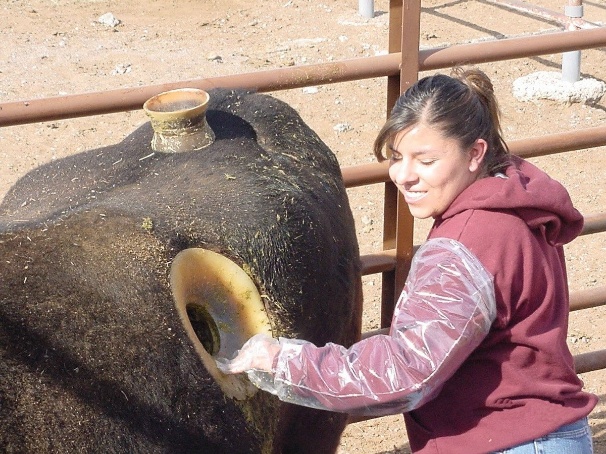
As a result, everyone is good: the cow does not have tympania, the owner does not need to call the veterinarian
Conclusion
Timpania in cattle can cause a lot of trouble for the owner, primarily due to the large size of the animal. With small ruminants, everything is easier, since they can be "taken on the arms" by rearing up by the front legs. In cattle, it is better to avoid tympania than to eliminate the consequences of malnutrition of the animal later.
